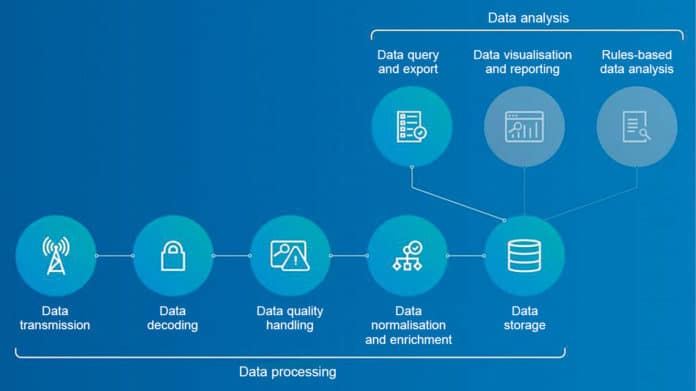The Internet of Things (IoT) device management enables users to track, monitor and manage the devices to ensure these work properly and securely after deployment.
Billions of sensors interact with people, homes, cities, farms, factories, workplaces, vehicles, wearables and medical devices, and beyond. The Internet of Things (IoT) is changing our lives from managing home appliances to vehicles. Devices can now advise us about what to do, when to do and where to go. Industrial applications of the IoT assist us in managing processes, and predicting faults and disasters. The IoT platforms help set and maintain parameters to refine and store data accordingly.

Data management is the process of taking the overall available data and refining it down to important information. Different devices from different applications send large volumes and varieties of information. Managing all this IoT data means developing and executing architectures, policies, practices and procedures that can meet the full data lifecycle needs.
Things are controlled by smart devices to automate tasks, so we can save our time. Intelligent things can collect, transmit and understand information, but a tool will be required to aggregate data and draw out inferences, trends and patterns.
Developers and manufacturers of embedded systems and devices need to build systems that answer the demands of data management. They need to design a data management framework compatible with all the software and hardware that play a role in collecting, managing and distributing data. The design needs to be efficient to accelerate time-to-market of the end-product.
Data from IoT devices is used for analytical purposes. Information that businesses collect and store but remains relatively stagnant, because it is not used for analytical purposes, is called dark data. It includes customer demographic information, purchase histories and satisfaction levels, or general product data. To better understand customers, dark data is invaluable to businesses, as it allows them to uncover additional insights more efficiently.
Before the release of a product, IoT data management requires field tests. Data from the field tests helps improve the design and create a higher-quality product. Collecting field data post-launch helps in continuous product improvement with software updates and by identifying anomalies. This also provides important insights to support the development process of new products.
The IoT data management
In edge computing, data is processed near the data source or at the edge of the network. While in a typical cloud environment, data processing happens in a centralised data storage location. By processing and using some data locally, the IoT saves storage space for data, processes information faster and meets security challenges.
Edge computing, data governance policies and metadata management help firms deal with issues of scalability and agility, security and usability. This further assist them decide whether to manage data on the edge or only after sending it to the cloud.
Sensors produce a large amount of data for edge gateway devices so that these can make decisions by analysing the data. These high-performance systems not only need to collect data in real time but also to organise and provide data to other systems.
Sensors and devices can connect indirectly through the cloud, where data is centrally-managed, or send data directly to other devices to locally collect, store and analyse the data, and then share selected findings or information with the cloud. Edge devices for data management help secure the most valuable data and reduce bandwidth cost. These also provide great performance, ownership over data and lower maintenance cost.
Edge devices run a Web-based dashboard that end-users can access to monitor the flow of data, so they can decide how various systems in demonstration and devices are running, and get notified by alarms. A large amount of data can be represented in the form of a graph for any desired range of time, and each point on the graph represents a record that can be found by searching the database, which stores a large quantity of data.
AWS IoT device management
This is critical across industrial, consumer and commercial applications such as an industrial and connected home. It enables customers to manage large and diverse device fleets such as operational technology systems, cameras, machines, vehicles, appliances and more.

It enables monitoring of usage and performance metrics for devices across industrial sectors such as manufacturing, oil and gas, and mining. It allows monitoring metadata and policy changes with service alerts to inform about any adjustments to the devices’ configuration. It also allows detection of any unusual behaviour across a device and to take mitigating actions.
It provides secure onboarding, organising, monitoring, troubleshooting and sending of firmware updates over-the-air (OTA). It enables adding device attributes like device name, type and manufacturing year, certificates and access policies to the IoT Registry. Then, it assigns them to devices, and makes connected devices ready for service quickly. This helps to quickly search and find any IoT device across the entire device fleet in near real time.
It is easy to find devices based on a combination of attributes like device ID, device state and type, so that action can be taken, in addition to troubleshooting. Actions such as reboots, factory resets and security patches can also be remotely executed.
Data management challenges
With time, the number of IoT devices will increase, thus increasing the challenges for real-time processing and analysis to reduce time for storage. Space has to be optimised for metadata like user IDs and passwords to ensure enough space for new information.
Functions such as adaptive maintenance, predictive repair, security monitoring and process optimisation rely on real-time data. Selecting the right tools is a challenge because integration between different sensors should be proven and compatibilities confirmed. When there is no connection, devices must still gain insights, make decisions and prepare for data distribution.
There are important factors behind an IoT device data management platform, including interoperability, scalability, security and standards offered by software technologies to build IoT products. It is important to protect data from unauthorised access and tampering. Organisations need to be compliant with national rules and regulations on securing data.
IoT device data also need to be checked for quality. Having many different devices connected directly to cloud services presents a huge attack surface, which can be mitigated by channelling data through a secure gateway device.
Potential of IoT device management
IoT device management software enable users to track, monitor and manage physical IoT devices to ensure they work properly and securely after deployment. These tools often allow them to push software and firmware updates to devices and troubleshoot problems remotely.
They also provide permissions and security capabilities to ensure each device is protected from vulnerabilities. These solutions are mainly used by IT administrators to track performance, security and the overall state of each connected device.
Exploring IoT data from the field will give a better idea of how the product functions in a user’s day-to-day life. IoT data management lets the user optimise smart algorithms by looking at sensory data and the points in time when a user made a change. Then, the user can redesign or retrain the product to offer a better user experience.












